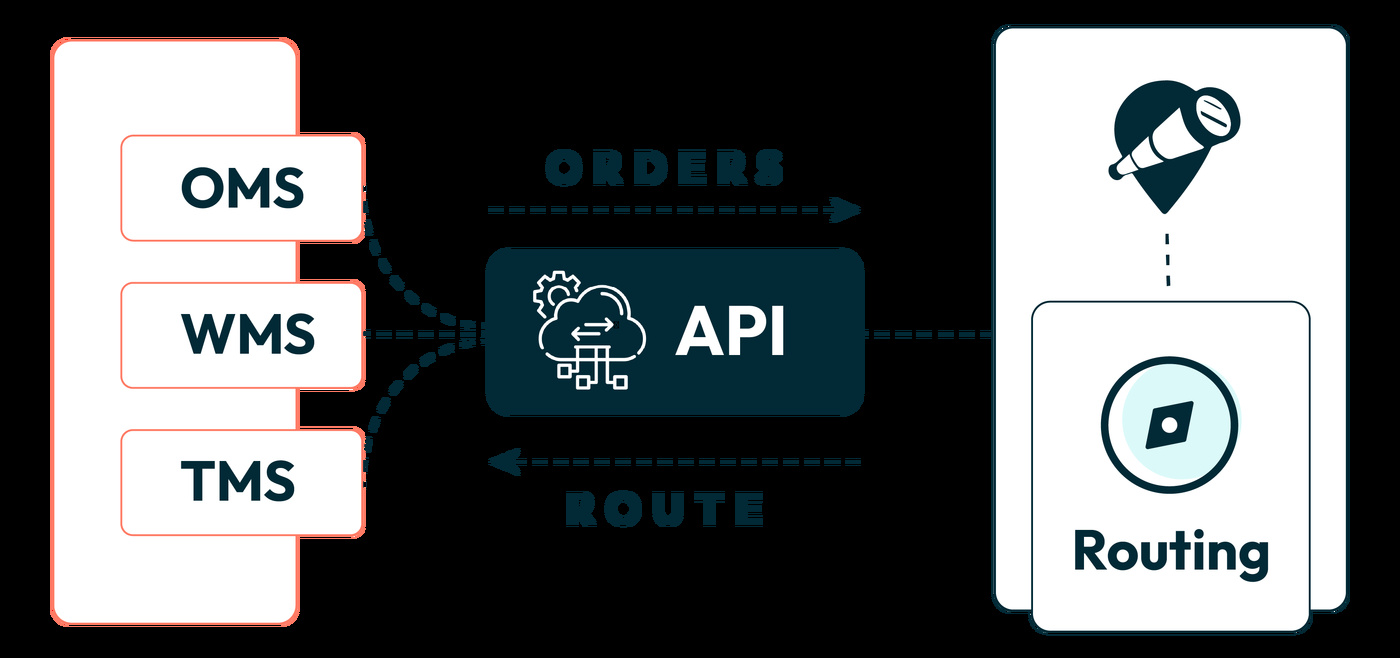- Route
Cloud Fleet Routing: Real-Time Data for Smarter Delivery Decisions
Table of Contents
- Why Real-Time Data Is a Game-Changer in Fleet Management?
- Understanding Cloud Fleet Routing
- Why APIs Are the Smarter Choice Over Monolithic Fleet Solutions?
- Exploring the Cloud Fleet Routing API
- Components of a Robust Cloud Fleet Routing System
- Overcoming Common Delivery Challenges with Cloud Routing
- Why FarEye Leads the Pack?
- Ready to Streamline Your Routes with Cloud Fleet Routing?

According to a report, up to 55% of consumers will abandon their favorite brands if deliveries are consistently late. Meanwhile, Statista estimates that global e-retail sales will exceed $8.3 trillion by 2027, underscoring the colossal volume of daily shipments.
In the face of skyrocketing customer expectations and rising operational costs, businesses need more than manual planning or basic mapping software. They require a truly adaptive system—one that utilizes real-time data to instantly re-route drivers around traffic, manage last-minute changes, and reduce operational overhead.

This is precisely what cloud fleet routing brings to the table: the ability to stay nimble in a market where on-time delivery can make or break brand loyalty.
Why Real-Time Data Is a Game-Changer in Fleet Management?
In the past, fleet managers primarily relied on manual route planning, spreadsheet-based schedules, and offline navigation tools. However, these methods struggle to accommodate last-minute order changes, sudden weather disruptions, or unexpected traffic bottlenecks.
Here’s why real-time data is indispensable:
- Live Traffic Updates
Congestion can turn a 30-minute route into a two-hour ordeal. Real-time data continuously scans traffic feeds, road closures, and incident reports, allowing immediate rerouting to avoid delays. - On-the-Fly Adjustments
Fluctuations in delivery priority, vehicle breakdowns, or capacity constraints demand dynamic recalculations. Real-time data ensures fleets respond to these shifts instantly. - Enhanced Customer Experience
Today’s customers expect precise ETAs and proactive delivery updates. Integrating live GPS tracking into your scheduling system allows you to push notifications or alerts to customers whenever there’s a significant delay or a change in route. - Cost Optimization
The shorter and more direct the route, the better. Real-time data helps prevent wasted mileage, cutting both fuel costs and carbon emissions.
By taking advantage of real-time intelligence, dispatchers and supply chain managers can make decisions that are data-driven rather than reactive or guess-based.
Understanding Cloud Fleet Routing
Cloud fleet routing is the practice of using web-based platforms and algorithms to plan, optimize, and execute fleet routes. Rather than relying on on-premises hardware and siloed data, everything is accessible in the cloud, offering:
- Scalability: Need to handle a sudden spike of orders? The system auto-scales resources in the cloud so your routing remains efficient during peak or seasonal surges.
- Centralized Data & Analytics: All route, vehicle, and customer data is aggregated for easy access—no more chasing multiple spreadsheets or unlinked databases.
- Collaboration: Dispatchers, drivers, and managers can all log into a single portal from various locations to review routes, communicate, and update order statuses.
- Cost Efficiency: With a cloud subscription model, you pay for what you use, reducing the capital expenditure on on-site servers or specialized IT teams.
In many ways, cloud fleet routing goes beyond mere route planning. It includes a suite of features like driver mobile apps, real-time tracking dashboards, automated scheduling, load balancing, and more. This holistic approach helps ensure that each driver has the most efficient sequence of stops and that the entire delivery operation is orchestrated with minimal friction.
Why APIs Are the Smarter Choice Over Monolithic Fleet Solutions?
Many businesses assume that achieving delivery excellence requires investing in a full-suite logistics platform. But this one-size-fits-all approach often adds unnecessary complexity, long implementation timelines, and rigid processes that don’t scale well with dynamic delivery environments.
That’s where cloud fleet routing APIs offer a compelling alternative. Instead of overhauling your tech stack, APIs allow you to plug powerful routing capabilities into your existing systems—from ERPs to order management and CRM tools. This modular integration ensures your team can retain existing workflows while upgrading your routing logic in the background.
Moreover, APIs offer greater agility. Want to re-prioritize high-value customers in your routing logic? Need to enforce fleet-specific constraints like delivery windows or vehicle restrictions? With an API-first strategy, these changes are easier to configure, test, and deploy, without affecting the larger operational ecosystem.
Ultimately, APIs help companies build bespoke, scalable, and cost-efficient fleet solutions tailored to their business needs—without being locked into a bulky platform.
Exploring the Cloud Fleet Routing API
A cloud fleet routing API plays a central role in integrating routing capabilities with your existing systems—be it an enterprise resource planning (ERP) suite, a warehouse management system (WMS), or an e-commerce platform. The API connects your order data, vehicle constraints, and delivery parameters to a powerful routing engine in the cloud.
Key Advantages of a Cloud Fleet Routing API:
- Real-Time Route Calculation
The API ingests live data—traffic updates, vehicle availability, new orders—and recalculates routes on demand. This ensures you’re never locked into a static route. - Seamless Integration
By calling the API from your custom applications, you can automatically generate or update routes whenever a new order is placed, an existing order is rescheduled, or a driver confirms a completed delivery. - Customized Constraints & Preferences
If you have unique constraints—like vehicle temperature requirements, hazmat regulations, or multi-compartment vehicles—the API can be configured to factor these in. This level of customization is essential for many B2B and B2C enterprises. - Scalable Compute Power
Most cloud routing APIs tap into powerful server clusters. Even if you need to optimize hundreds or thousands of routes simultaneously, the system can handle it without hogging your local server resources. - Data-Driven Insights
APIs typically log route performance metrics—travel time, idle time, and on-time delivery rates—providing a wealth of analytics to refine strategies. Over time, you can spot trends, reduce operational costs, and improve delivery reliability.
Components of a Robust Cloud Fleet Routing System
An end-to-end cloud fleet routing solution typically includes these core components:
- Dynamic Route Optimization
Algorithms that factor in distance, time, traffic, vehicle capacity, driver availability, and delivery time windows.
The system recalculates routes whenever new data or constraints emerge. - Driver Mobile App
Gives drivers real-time instructions, turn-by-turn navigation, and the ability to record proof of delivery.
Provides a feedback loop for dispatchers, including completed stops, route deviations, or unexpected delays. - Real-Time Tracking Dashboard
Dispatchers see a live map of vehicle locations.
Alerts pop up for major delays, missed windows, or urgent new orders needing reallocation. - Integration Modules
APIs or plug-ins for connecting to ERP, CRM, or e-commerce systems.
Automated data flow ensures the route engine always has accurate order, inventory, and customer information. - Analytics & Reporting
Historical data on route efficiency, driver performance, fuel consumption, and on-time rates.
Helps supply chain managers pinpoint bottlenecks or inefficiencies and refine operational strategies. - Scalability & Security
Enterprise-grade solutions must handle surges in volume without downtime.
Data encryption and access control protect sensitive client or order information.
Overcoming Common Delivery Challenges with Cloud Routing
- Last-Minute Order Additions
In any high-volume environment, there’s always that customer who places an order at the eleventh hour. With a cloud fleet routing API, you can seamlessly insert new stops into a driver’s route and recalculate an ETA in real time. - Traffic Congestion & Road Closures
Congestion in urban areas can derail even the best route plan. A dynamic cloud solution re-routes drivers around incidents, ensuring minimal delays and customer dissatisfaction. - Large Delivery Volumes & Multiple Constraints
Enterprises often juggle thousands of deliveries with complex constraints—like temperature-controlled packaging or region-specific regulations. Advanced routing solutions accommodate these details, ensuring no vehicle is over-capacity, and every regulation is adhered to. - Customer Expectations for Transparency
In a world dominated by apps and on-demand services, customers want to track their deliveries minute by minute. Cloud fleet routing integrates with tracking software to deliver accurate ETAs and live updates, mitigating “where is my package?” phone calls.
Why FarEye Leads the Pack?
When it comes to addressing the full spectrum of route challenges, FarEye stands out as a proven, scalable solution. Here’s why:
- Advanced Route Planning Software
As detailed on FarEye’s route planning software page, FarEye’s algorithms consider multiple real-world variables: traffic forecasts, driver schedules, and even fleet capacities. This holistic approach ensures deliveries happen on time while minimizing inefficiencies. - Cloud Fleet Routing API
FarEye’s cloud fleet routing API is designed for seamless integration, allowing businesses to connect their existing systems—like CRMs, ERPs, or e-commerce platforms—directly to FarEye’s optimization engine. The result? Real-time routing that updates the moment new data is available. - Robust Developer Resources
Through the developer portal, your tech team can quickly embed FarEye’s capabilities into your workflows. The platform provides comprehensive documentation, sample requests, and tutorials for setting up route calculations, fetching delivery slots, and more. - Real-Time Adaptability
FarEye’s technology constantly factors in real-time data—traffic disruptions, urgent customer requests, or driver performance. This ensures your routes never become static or outdated. - Analytics and Continuous Improvement
Beyond merely plotting routes, FarEye logs data from every completed trip. These analytics empower supply chain leaders to improve planning strategies, forecast staffing needs, and even renegotiate carrier contracts armed with real performance metrics. - Global Scalability & Security
Trusted by enterprises across geographies, FarEye’s platform can handle the load for companies with vast fleets, large order volumes, and complex distribution networks. Security features like data encryption and role-based access ensure that sensitive information remains protected.
Ready to Streamline Your Routes with Cloud Fleet Routing?
Cloud fleet routing—fueled by real-time data—promises a smarter, more agile way to ensure each delivery arrives on time and on budget. Whether you manage a handful of trucks or a global fleet, integrating Fareye’s cloud fleet routing API into your operational blueprint is no longer optional—it’s a strategic imperative.
Leverage the transformative power of cloud fleet routing, lean on real-time insights, and watch your deliveries evolve from a daily headache to a strategic advantage. Now is the time to invest in a future-proof logistics strategy that not only meets today’s operational hurdles but anticipates tomorrow’s opportunities.
Reference:
https://www.statista.com/statistics/379046/worldwide-retail-e-commerce-sales/

Komal Puri is a seasoned professional in the logistics and supply chain industry. As the AVP of Marketing and a subject matter expert at FarEye, she has been instrumental in shaping the industry narrative for the past decade. Her expertise and insights have earned her numerous awards and recognition. Komal’s writings reflect her deep understanding of the industry, offering valuable insights and thought leadership.
Let's Talk to Our Experts and Optimize Your Deliveries Today!
An expert from our team will reach out within 24 hours
Related resources


